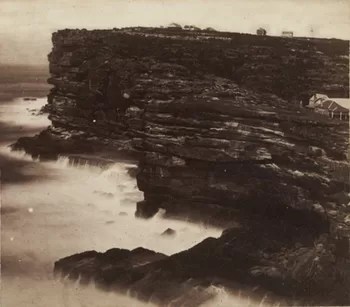The wreck of the Dunbar remains one of Australia’s most poignant maritime disasters. On the stormy night of August 20, 1857, the majestic clipper ship met a tragic end at the treacherous cliffs near Sydney’s South Head. This shipwreck disaster not only claimed the lives of 121 souls but also left an indelible mark on the history of Sydney.
Our story of the Dunbar continues after this advertisement:
The Dunbar: A Symbol of Prosperity
The Dunbar, built in 1852 in Sunderland, England, was a state-of-the-art vessel known for its speed and elegant design. It was primarily used to transport passengers and cargo between England and Australia, reflecting the burgeoning trade and emigration of the mid-19th century.
The ship, under the command of Captain James Green, was making its second voyage to Sydney, carrying 63 passengers and a crew of 59, along with a valuable cargo.

The Fateful Night
As the Dunbar approached Sydney after a three-month voyage from Plymouth, it encountered a severe storm.
The weather was atrocious, with torrential rain and howling winds making navigation exceptionally difficult.
Captain Green, misjudging his position in the darkness and inclement weather, steered the ship too close to the cliffs at South Head.
At around midnight, the Dunbar struck the rocky coastline and was dashed against the cliffs.
The ferocity of the storm and the violence of the impact meant that the ship quickly broke apart, leaving little chance for those on board to survive.
The Aftermath and the Sole Survivor
Out of the 122 people aboard, only one survived. James Johnson, an able seaman, was the sole survivor of this catastrophic wreck. He managed to cling to a rocky ledge throughout the night and was rescued the following day.
His harrowing tale of survival was widely reported and he became a poignant symbol of the disaster.
The bodies of the victims, along with debris from the ship, washed up along the shores, creating a gruesome and heart-wrenching scene. The city of Sydney was in mourning, as many prominent citizens were among those lost.
The scale of the disaster led to a mass funeral held at St. Stephen’s Church in Camperdown, attended by thousands of grief-stricken residents.

Memorial and Legacy
In the wake of the tragedy, the wreck of the Dunbar led to significant changes in maritime safety.
One of the most notable outcomes was the construction of the Hornby Lighthouse at Watsons Bay in 1858, designed to guide ships safely into the Sydney Heads.
Today, the story of the Dunbar is remembered through various memorials. The most notable is the Dunbar Memorial in Camperdown Cemetery, where many of the victims are buried.
The ship’s anchor, recovered from the wreck site, is displayed at Watsons Bay, serving as a tangible reminder of the disaster.
The legacy of the Dunbar wreck continues to resonate with Sydneysiders and visitors alike.
The tragic event is not only a part of Sydney’s rich maritime history but also a sobering reminder of the dangers faced by those who traveled the seas during the age of sail.
The wreck of the Dunbar is a somber chapter in Sydney’s history, reflecting the perilous nature of maritime travel in the 19th century.
While it was a disaster of immense human tragedy, it also brought about crucial improvements in navigation and safety, helping to protect future generations of seafarers.
Today, the memory of the Dunbar and those who perished serves as a poignant reminder of the bravery and resilience of those who ventured across the seas in search of a new life.
Solving the Mystery of Figurines Recovered from the Wreck of the Dunbar
The Conservation team at the Australian National Maritime Museum has unraveled the mystery surrounding six animal figurines discovered among the remains of the 1857 wreck of the Dunbar. They are now seeking anyone who might have these intriguing objects in their homes.

These items, part of the museum’s Dunbar collection, are some of the personal belongings and commercial goods that were being transported from England to Australia before the devastating loss of the vessel near the entrance to Sydney Harbour in 1857.
Without an official manifest and after centuries of oceanic degradation, many unique objects have lost their identity and purpose outside of their connection to the Dunbar.
Initially thought to be decorative umbrella handles, riding crop knobs, or accessories for walking sticks and canes, these objects are now believed to be ornate cabinet knobs, iconic symbols of Victorian aristocracy during the late 19th century, likely cast in England.
The removal of minute corrosion deposits revealed threading at the base of each figurine, identifying their distinct purpose and narrowing the possibilities to a handful.
This discovery was made almost entirely by coincidence with the use of microscopes and specialized probes, which were not easily accessible when the collection first came to the museum in the 1990s.
Does anyone have one of these in their home? The museum is keen for answers.
Museum Director and CEO Ms. Daryl Karp stated, “This fascinating discovery has piqued the curiosity of everyone at the museum. We are now turning to the public and asking anyone who may own these ornate cabinet handles to please reach out to us so that we might be able to confirm this discovery.”
If you believe you may own these cabinet handles, please contact media@sea.museum with relevant information and images.

Three masted ship Dunbar in full sail on open ocean. It was built in 1854 and was wrecked in August 1857 off South Head, Sydney, N.S.W.
Efforts at Salvage: The Wreck of the Dunbar
Following the devastating wreck of the Dunbar in 1857, the efforts to salvage what remained of the ship were both extensive and challenging. The rough seas and the treacherous location of the wreck made the task formidable, yet determined salvors persevered in their efforts to recover anything of value and to bring closure to the tragic event.
Immediate Salvage Attempts
In the immediate aftermath of the wreck, the priority was the recovery of bodies and any survivors. James Johnson, the sole survivor, was found clinging to the cliffs and was rescued, but the bodies of the other victims were scattered along the coastline, requiring a massive recovery effort.
Volunteers, local fishermen, and authorities worked tirelessly to retrieve and identify the bodies, which were then buried with great solemnity.
Recovery of Valuable Cargo
Once the grim task of body recovery was underway, attention turned to the valuable cargo the Dunbar had been carrying. The ship was laden with merchandise intended for the burgeoning colony, including fine goods, building materials, and personal belongings of the passengers.
The salvage operation faced numerous challenges:
- Weather Conditions: The seas remained rough for days after the wreck, complicating efforts to approach the site.
- Location: The ship had broken apart against the cliffs, with debris scattered over a wide area and much of it submerged or lodged in difficult-to-reach places.
- Technology: The salvage technology of the mid-19th century was rudimentary compared to modern standards, relying on basic diving equipment and manual labor.
Despite these obstacles, divers and salvage crews managed to recover a significant amount of the ship’s cargo. Notable recoveries included crates of goods, personal items belonging to passengers, and parts of the ship itself.
The Anchor and Artifacts
One of the most iconic items recovered from the wreck was the Dunbar’s anchor. This massive piece of iron was a challenging but symbolic salvage, representing the strength and size of the ill-fated ship. The anchor, now displayed at Watsons Bay, serves as a poignant reminder of the disaster and the efforts to salvage the remains.
Other artifacts recovered over the years have included:
- Coins and Jewelry: Personal items that once belonged to the passengers and crew, offering a glimpse into the lives lost.
- Ship’s Fittings: Parts of the ship’s structure and fittings, including rigging and timbers, have been recovered and preserved.
- Cargo Items: Various goods intended for trade and personal use that were part of the ship’s valuable cargo.
Continued Efforts and Memorials
The salvage of the Dunbar did not end with the immediate recovery efforts.
Over the years, continued diving expeditions and explorations have uncovered additional artifacts and remnants of the ship. These efforts have been driven by both professional archaeologists and amateur divers fascinated by the history of the wreck.
Today, the story of the Dunbar is preserved through several memorials and museum displays. The artifacts recovered from the wreck are invaluable pieces of Sydney’s maritime heritage, and they help tell the story of the Dunbar to new generations.
The anchor at Watsons Bay, in particular, stands as a powerful symbol of the tragedy and the efforts to salvage what could be saved from the sea’s grip.
The salvage efforts following the wreck of the Dunbar were marked by bravery, perseverance, and a deep sense of duty to the memory of those who perished.
While the physical remnants recovered from the site provide tangible links to the past, it is the stories and memories of the Dunbar and its passengers that continue to resonate most strongly. The efforts at salvage were not just about recovering material goods but about honoring the lives lost and ensuring that the lessons of the disaster were not forgotten.
Resources
Related stories
Cobb & Co: The Pioneers of Australia’s Stagecoach Era
James Steele, Engineer, Australian Agricultural Company
Photographer Paul Dubotzki in Australia’s WWI Internment Camps
Honouring the memory of Australian war correspondents
Top 10 Rare Valuable and Collectible Vinyl Records
Are Old & Vintage Corkscrews Collectible?
Guide to Collecting Vintage Film Cameras
An account of the life of Captain James Cook
Police Ephemera ° The value of Victorian reward posters



